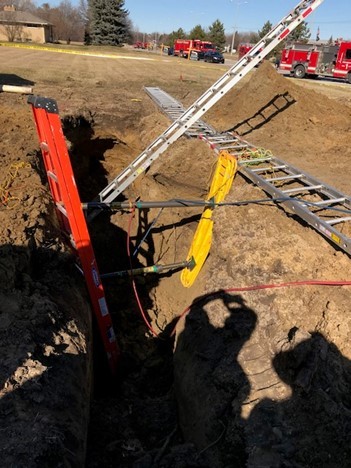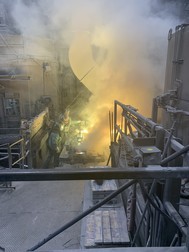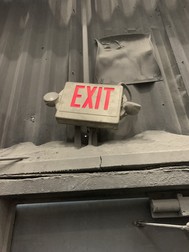Bart Pickelman, MIOSHA Director

The new year presents an opportunity to look towards the future and develop strategies to improve health and safety for the working people in Michigan. It also allows us to review MIOSHA accomplishments from the previous year. MIOSHA’s strategic plan helps focus operations to accomplish agency goals and covers fiscal years 2019 through 2023. As MIOSHA enters the last year of the current plan, preparations for the next five-year plan have already begun.
MIOSHA initiated the development of the next strategic plan by holding focus group meetings with representatives from the construction industry, general industry and labor organizations to obtain feedback and suggested improvements for the new plan. Engagement of a larger stakeholder group will occur prior to finalizing the next plan in 2023.
MIOSHA accomplished the vast majority of the objectives in the current strategic plan during 2022. Injury and illness rates declined in most of the targeted high hazard industries, participation goals for MIOSHA’s cooperative programs such as Partnerships, Alliances, the Michigan Voluntary Protection Program (MVPP) and the Michigan Safety and Health Achievement Recognition Program (MSHARP) were all achieved. The enforcement divisions responded to all employee complaints within 10 days and the consultation group added to the MIOSHA Training Institute course offerings.
Our hope for the coming year is more Michigan employers and employees view MIOSHA as a resource to improve workplace health and safety and take advantage of MIOSHA’s services. If we work together on the shared goal of improved workplace health and safety, more working people in Michigan will go home to their family and friends at the end of their shift healthy and whole.
|
Gloria Keene, MIOSHA Training Institute Program Coordinator, Consultation Education and Training Division
Safety is always in season! Join us this spring to be part of a new and exciting MIOSHA Training Institute (MTI) offering in the construction sector.
From March 6-9 and March 13-16, MIOSHA will pilot this first-ever MTI Construction Boot Camp at Lawrence Technological University in Southfield. The boot camp will allow participants to complete training in two weeks, rather than taking classes for months. MIOSHA invites you to attend the pilot at half the cost of a regular MTI boot camp in return for your feedback.
Participants will receive a 30-Hour Occupational Health and Safety Construction course card and a MIOSHA Level One Construction Safety and Health Certificate. Participants will also receive two additional electives that can be used toward a MIOSHA Level Two Construction Safety and Health Certificate.
This training covers several topics, including scaffold safety, fall protection, health hazards in construction, excavations, personal protective equipment and electrical safety. Participants will increase their knowledge of identifying, preventing and controlling workplace hazards. This training will also enable employers to establish a foundation of safety within their organizations while reducing hazards and injuries.
To learn more about this boot camp or MTI and what it can do for you, contact MIOSHA’s Consultation Education and Training Division at 517-284-7720, or visit Michigan.gov/mti.
Anna Horvath, Health and Safety Manager, Eaton Grand Rapids
At the end of the year, employees often enjoy time off celebrating the holidays and spending time with friends and family. When employees return to work in January it is important to welcome them back and encourage them to refocus on work tasks as well as hazards and controls in their workstations. Injuries tend to occur when employees are distracted, fatigued or overwhelmed, which are all potential factors when returning from time off.
At the Eaton Grand Rapids site, we begin each year with a series of ‘January Safe Start’ activities to remind us that safety is our number one priority and allow employees to dedicate time to assess the risks and controls in their work areas and site wide. These activities are planned ahead of time with support and input from leadership and safety team members. Adding in engaging games, challenges and prizes helps energize employees while reinforcing key safety messages.
Below are several examples of Safe Start activities:
-
All Employee Safe Start Meeting – We start the year with an all employee meeting on day one to review the site’s safety policy, remind employees of various safety programs offered at the site and review the previous year’s highlights, performance and trends.
-
Welcome Back Safety Checklist – Employees complete a checklist to review their work area for unsafe conditions. The checklist asks questions about ergonomics, personal protection equipment availability, slips, trips, fall hazards and a variety of other potential risks that employees should be considering on a daily basis. Employees who turn in completed checklists are entered into a raffle to win prizes.
-
Risk Assessment Review – Employees start the day by reviewing the risk assessment documentation in their areas and updating as needed.
-
Hazard Hunt – Employees are encouraged to submit observations and near misses using our online observation tool. The top three submissions from the first week are chosen and prizes are given to the winners.
-
Safety Jeopardy – Employees are divided into groups and participate in a game of Safety Jeopardy, led by site leadership. Candy is passed out for correct answers and prizes are given to the employees with the highest number of points.
Eaton Aerospace in Grand Rapids has 165 employees and has been an Michigan Voluntary Protection Program STAR site since 2017. The site produces electro-mechanical actuation components for the aerospace industry. Safety and employee engagement are critical to the site’s success and sharing and learning best practices is a key factor in our continuous improvement process.
Eric Allen, Health and Safety Manager, Construction Safety and Health Division

On Feb. 26, 2018, a property owner employed a person to install a cap on a building sewer line in Sterling Heights. The sewer line was located underground in close proximity of a commercial building on the property.
The employee used an excavator to dig as deep as the excavator was capable and the spoil piles were set directly adjacent to the excavation. The employee entered the excavation with a step ladder to perform the remainder of the digging and capping activities. The trench was approximately six-feet wide, 29-feet long, and nine-feet deep. The walls of the excavation were not supported by a support system such as a trench box, or within the proper angle of repose (slope).
While the property owner was watching the work activities, the excavation collapsed, burying the worker. Emergency services were summoned.
|
Municipal Fire services arrived and began rescue operations. Due to the worksite conditions, multiple municipal services were needed to extricate the victim. After several hours, the rescue attempt changed to a recovery operation.
MIOSHA Construction Safety and Health Standard Rules cited related to this fatality inspection
Part 1. General Rules; Rule 408.40114(1): An employer shall develop, maintain and coordinate with employees an accident prevention program, a copy of which shall be available at the worksite.
Part 1. General Rules; Rule 408.40132(3): A person who has a valid certificate in first aid training shall be present at the worksite to render first aid. A certificate is valid if the requirements necessary to obtain the certificate for first aid training meet or exceed the requirements of the United States Bureau of Mines, the American Red Cross, the guidelines for basic first aid training programs, or equivalent training.
Part 9. Excavation, Trenching, and Shoring; Rule 408.40932(4): An ongoing inspection of an excavation or trench shall be made by a qualified person. After every rainstorm or other hazard-producing occurrence, an inspection shall be made by a qualified employee for evidence of possible slides or cave-ins. Where these conditions are found, all work shall cease until additional precautions, such as additional shoring or reducing the slope, have been accomplished.
Part 9. Excavation, Trenching, and Shoring; Rule 408.40933(2): An excavation that an employee is required to enter shall have excavated and other material stored and retained not less than two feet from the excavation edge.
Part 9. Excavation, Trenching, and Shoring; Rule 408.40941(1): The side of an excavation more than five feet deep shall be sloped as prescribed in table one, unless supported as prescribed in this part.
The incident resulted in two inspections, one related to the fatality and one related to the other issues discovered during the investigation.
The MIOSHA Construction Safety and Health Division (CSHD) encourages employers to be aware of the hazards presented by excavations. Federal Occupational Health and Safety and MIOSHA continue to focus on excavation hazards. Unfortunately, excavation fatalities continue to occur around the country and here in Michigan. We encourage all employers to slope, shore or shield excavations.
MIOSHA urges employers to go above and beyond the MIOSHA Standards, which are a minimum. MIOSHA Consultation, Education, Training (CET) Division provides onsite consultation, hazard surveys and training to employers. If you are interested in free assistance, please complete the MIOSHA CET Request for Consultative Assistance. MIOSHA CET offers a variety of safety and health training courses through the MIOSHA Training Institute. MIOSHA also has a webpage specifically dedicated to Excavation and Trenching hazards.

Kathlyn Bernardoni, Certified Safety Professional, Industrial Hygienist, General Industry Safety and Health Division
MIOSHA was able to help identify and subsequently reduce employee exposures to lead, mechanical hazards and confined space hazards during recent investigations at a brass foundry.
Brass foundries are part of the Primary Metal Manufacturing industry (NAICS 331), a group targeted by MIOSHA’s 2019-2023 five-year strategic plan to reduce the total incidence rate for worker injuries; roughly 18,300 Michiganders are employed in this industry. Common health concerns faced by employees in this industry include:
- Burns
- Musculoskeletal injuries and illnesses
- Eye injuries
- Hearing loss
- Respiratory ailments (particularly silicosis)
- Effects from various chemical exposures (notably those from lead, carbon monoxide, beryllium and metal dust and fumes)

An employee complaint regarding conditions at the facility triggered separate health and safety inspections. During the health inspection, numerous permit-required confined spaces (PRCS) that employees routinely entered were identified by industrial hygienists. However, these spaces were not properly labeled or otherwise identified. Other PRCS deficiencies were lack of training, failure to complete entry permits or conduct air monitoring before entry and inadequate rescue services.
In addition, numerous housekeeping issues were documented, including multiple areas in the caster basement with standing water and unsecured boards serving as a walkway. There was ample evidence of employees eating, drinking and smoking in lead-controlled areas of the facility.
|
MIOSHA industrial hygienists conducted air monitoring for lead and formaldehyde for employees working in the lead-controlled areas, primarily on the melt deck and in the control rooms. Lead sampling results for the participating employees ranged from 13 µg/m3 to 111 µg/m3. Permissible exposure limit (PEL) for lead is 50 µg/m3 over an eight-hour period; the action level (AL) is 25 µg/m3. Of the ten employees monitored, six were found to be above the AL and two were found to be above the PEL. No overexposure to formaldehyde was found.

Wipe sampling revealed surface lead levels up to 2,600 µg lead/100 cm2 in areas where food was consumed and stored. While the MIOSHA lead standards require surfaces to be maintained as free from lead as practicable, the OSHA guideline for maximum surface lead level contamination is 500 µg lead/100 cm2.
A review of medical records uncovered multiple employees with blood lead levels exceeding the thresholds outlined in Part 310. Furthermore, employee interviews revealed gaps in lead hazard knowledge, including using home remedies (chelation therapy) to remove lead from the system. According to the National Institute of Health (NIH), chelators have many potential side effects and can result in death due to their ability to remove essential metals from the body.
|

As a result of these hazards, MIOSHA only permits chelation therapy under the supervision of a licensed physician in a clinical setting with thorough and appropriate medical monitoring.
Although employees in the areas of lead exposure wore full-face, powered, air-purifying respirators, multiple incidents were observed where employees compromised the effectiveness of the respirators. Deficiencies included raising the respirator helmet’s facepiece to communicate with each other and unauthorized modifications of the respirators.
The health inspection resulted in eight serious, two repeat-serious and one other-than-serious citations being issued. The following deficiencies were cited:
|
Part 490. Permit-Required Confined Spaces
- 146(c)(4): There was no compliant permit-required confined spaces program.
- 146(c)(2): Permit-required confined spaces were not adequately identified.
- 146(c)(5)(ii)(C): Atmospheric testing was not conducted prior to entry.
- 146(e)(1): Entry permits were not completed.
- 146(g)(1): Employees did not have appropriate training.
- 146(d)(9): There were no procedures for summoning rescue services.
- 146(k)(1)(ii): The employer did not evaluate the ability of rescue providers to adequately respond to permit-required confined space rescues.
Part 310. Lead in General Industry
- 1025(f)(2)(i): The respiratory program was not compliant.
- 1025(h)(1): Lead was allowed to accumulate on surfaces.
- 1025(i)(1): Food, beverages and tobacco were used in areas of lead exposure.
- Rule 325.51933: Biological monitoring was not provided at appropriate intervals to employees exposed to lead above the permissible exposure limit.
- Rule 325.51943(2): The employer did not remove employees with high blood lead levels.
- 1025(j)(4)(i): The employer did not ensure that employees did not engage in prophylactic chelation.
- 1025(g)(2)(iii): The employer failed to repair or replace required protective clothing and equipment as needed.
- 1025(l)(1)(ii): The employer did not adequately annually train each employee on lead hazards.
Part 451. Respiratory Protection; 1910.134(h)(4): The employer did not ensure that respirators that failed an inspection or are otherwise found to be defective are removed from service.
Part 474. Sanitation; 1910.141(a)(3)(ii): The floors of workrooms were not maintained in as dry of a condition as was practicable.
Part 306. Formaldehyde; 1910.1048(d)(1)(i): The employer did not conduct initial monitoring to determine employee workplace exposure to formaldehyde.
Concurrent safety inspections resulted in an additional four serious and four other-than-serious citations.
The employer recognized the severity of the hazards and management implemented the following corrective actions:
- Did a thorough cleaning of the facility and implemented a cleaning maintenance program.
- Invested in new equipment for employees (headsets, respirators, fire-retardant clothing).
- Updated administrative controls.
- Removed individuals with high blood-lead levels from lead-controlled areas.
- Updated biological monitoring schedule.
- Updated training and retrained employees for lead and confined space hazards.
- Contracted with a third party for confined space testing and rescue operations.
Shannon Matsumoto, Manager, Standards and FOIA Section, Technical Services Division
MIOSHA is in the process of reviewing General Industry Safety and Health Standard Part 73: Fire Brigades. The current rules are being revised to adopt by reference National Fire Protection Association (NFPA) standard 1971 Standard on Protective Ensembles for Structural Fire Fighting and Proximity, 2007 and 2013 editions.
Due to other legislation, the Michigan Occupational Safety and Health Act, Act 154 of 1974 was amended to require the Director of Labor and Economic Opportunity to promulgate rules regarding a firefighter’s use of firefighting foam concentrate containing a perfluoroalkyl or polyfluoroalkyl substance (PFAS).
Stay tuned for final versions to be added to the MIOSHA standards web page once they are approved.
Dawn Jack, Director, Appeals Division
On Sept. 9, 2022, the Board of Health and Safety Compliance and Appeals issued its final decision on a contested citation issued by the MIOSHA General Industry Safety and Health Division. The citation stemmed from an investigation into an injury accident that occurred on Aug. 24, 2020.
On the date of the accident, the company’s employees were engaged in trimming trees along an electric power line right of way. Under the supervision of the foreman, the injured employee secured the tie-in point for his climbing line into the crotch point of a tree and began trimming the limbs. As the employee attempted to reposition by loosening the safety strap securing him to the tree trunk, the employee fell from the tree, causing his climbing line to swing the employee approximately 20 feet into the neutral line and then the 7,200-volt live primary power line, ultimately setting fire to the employee. The employee suffered first and second-degree burns requiring skin grafts and eight weeks of hospitalization. Upon recovery, the employee resumed employment with the company in another position.
The MIOSHA investigation resulted in the issuance of a $7,000 serious violation under Section 11(a) of the Michigan Occupational Safety and Health Act, commonly known as the general duty clause. Section 11(a) requires an employer to provide a workplace for their employees that is free from recognized hazards that are likely to cause serious physical harm or death.
MIOSHA asserted that the company had failed to protect the employee from electrical hazards by not ensuring the employee was properly crotched in the tree to allow for a swing radius away from a power line in the event of a fall. The company appealed the citation and penalty, resulting in an administrative hearing before an Administrative Law Judge (ALJ).
The legal standard of proof needed to establish a violation of the general duty clause differs from the proof needed to establish a violation of a MIOSHA safety and health standard or rule. To prove a violation of the general duty clause, MIOSHA must prove by a preponderance of the evidence (i.e., more likely than not) that:
- A condition or activity in the workplace exposed employees to a hazard;
- The employer or the employer’s industry recognizes the hazard;
- The hazard was causing, or likely to cause, serious physical harm or death; and,
- There was a feasible means available to protect the employee by eliminating or materially reducing the hazard.
At the hearing, the company asserted that a climber proficiency training program was in place, which included training on electrical hazard awareness, recognizing and avoiding electrical hazards in a tree, and climbing systems and tie-in procedures. The company’s witnesses testified that the injured employee had completed the company’s climber proficiency training, which included oral testing, observing the employee on the job and talking to other workers who had observed the employee on the job. The company’s witnesses further testified that it conducted tailgate meetings every day and that corporate and regional employees conduct ongoing worksite inspections. The company also acknowledged that during the incident the foreman approved the tie-in point without considering the proximity of the power line; had recently become a foreman; had been “grandfathered” in based on his past periodic experience rather than passing a proficiency exam; and had not worked much with the injured employee. Neither the injured employee nor the supervisor was disciplined for the incident. A company official further testified that following the incident, the company instituted checklists as a part of the verification process for picking tie-in spots on trees.
After the hearing, the ALJ issued a decision ruling that while the employer had not proven employee misconduct, the citation should be vacated under Section 33(6) of the Act which states:
A citation for an alleged violation of this act, an order issued pursuant to this act, or a rule or standard promulgated pursuant to this act shall be vacated if it is shown that the employer has provided the equipment or training, educated employees regarding use of the equipment or implementation of the training, and taken reasonable steps including, where appropriate, disciplinary action to assure that employees utilize the equipment and comply with the training as referenced in this section.
Section 33(6) is commonly referred to as the employee misconduct defense. To prove employee misconduct as a defense to the citation, an employer must prove:
- It has an established work rule designed to prohibit the conduct or unsafe condition.
- It has effectively communicated the work rule to its employees.
- It has taken steps to discover or monitor for incidents of noncompliance with the work rule.
- It has an effectively enforced the rule to deter employees from violating the rule.
MIOSHA filed exceptions to the ALJ’s ruling, asserting that the ALJ had failed to analyze the general duty clause violation under the proper legal standard and that the evidence at the hearing did not support that ALJ’s conclusion that the company had satisfied the employee misconduct defense. Upon review of the ALJ’s decision and MIOSHA’s exceptions to the ruling, the board directed the ALJ’s ruling for further review and discussion at the board’s next scheduled meeting. During review and discussion of the case at the board’s July 8, 2022, meeting, the board determined:
- The ALJ had not applied the proper legal standard for the violation.
- The evidence supported a violation of the general duty clause.
- The evidence did not show that the employer had established the employee misconduct defense.
The board voted to overturn the ALJ’s ruling and reinstate the citation and penalty. On Sept. 9, 2022, the board reviewed and issued its formal opinion reversing the ALJ and reinstating the citation and penalty. No further appeal of the board’s decision was filed.
As of Dec. 2022, we currently have 19 Active MIOSHA alliances. Over the past year, we prepared, reviewed and processed 10 Alliance renewal agreements and signed two new Alliance agreements.
A list of MIOSHA Alliances can be found on the Alliance page.
Variances from MIOSHA standards are available to the public in accordance with Administrative Standards for All Industries, Part 12. Variances (R408.22201 to 408.22251). MIOSHA variances are published on the MIOSHA website: michigan.gov/mioshavariances.
|